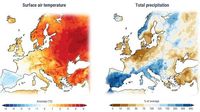Global temperatures soared to historically high levels in March 2025, continuing a nearly two-year streak of extraordinary heat. According to the Copernicus Climate Change Service (C3S), March 2025 was the second warmest March on record, with average global temperatures hitting 14.06°C (57.3°F). This marks only a slight drop of 0.08°C from last year's record-breaking March 2024, which had set a new high.
In Europe, the situation was even more pronounced, as the continent experienced its hottest March ever recorded. The average temperature across Europe reached 6.03°C (42.85°F), significantly surpassing the previous record set in 2014 by 0.26°C (0.47°F). This exceptional warmth has raised alarms among climate scientists, who note that the continent is warming faster than any other.
The extreme temperatures were not uniform across the continent. While some regions, including the Iberian Peninsula and southern France, experienced cooler and wetter conditions, other areas faced intense heat. Eastern Europe and parts of Southwest Russia reported temperatures well above historical averages. Samantha Burgess, deputy director of C3S, commented, "March 2025 was the warmest March for Europe highlighting once again how temperatures are continuing to break records."
Globally, March 2025 continued a trend that has seen virtually every month since July 2023 record temperatures at least 1.5°C (2.7°F) above pre-industrial levels. The month was 1.59°C (2.86°F) hotter than the average for 1850 to 1900, the period referred to as 'pre-industrial'. This makes March 2025 the twentieth out of the last 21 months to exceed the 1.5°C warming target established by the Paris Climate Agreement.
Climate change is increasingly recognized as a significant driver of these extreme weather events. Studies conducted by the World Weather Attribution (WWA) concluded that climate change intensified an extreme heatwave across Central Asia and contributed to conditions that led to deadly floods in Argentina, which resulted in 16 fatalities. The unpredictable nature of weather patterns, including contrasting extremes of drought and heavy rainfall, is becoming more frequent as a result of rising global temperatures.
March 2025's average temperature of 14.06°C is only slightly lower than the record set in March 2024, which was the hottest month ever recorded. This persistent heat wave has left scientists puzzled, as they expected temperatures to cool following the El Niño phenomenon that peaked in early 2024. Instead, the world has continued to experience high temperatures, leading to discussions about other contributing factors that may be amplifying these conditions.
Robert Vautard, co-chair of the climate working group for the IPCC, noted, "It's a situation exceptional because normally the temperatures drop significantly after two years of El Niño." He emphasized the importance of understanding the natural fluctuations that could be influencing these sustained high temperatures, as they are currently subject to significant interannual and decadal variations.
In addition to record temperatures, the month of March also saw concerning trends in sea ice levels. Arctic sea ice reached its lowest monthly extent in March in the 47-year satellite record, covering an area six percent smaller than the average. Antarctic sea ice also hit its fourth lowest monthly extent for March, standing 24 percent lower than average. This decline in sea ice is alarming, as it can have profound effects on global weather patterns and marine ecosystems.
Average sea surface temperatures also reached significant highs, hitting 20.96°C (69.72°F), making it the second highest on record and just 0.12°C below the March 2024 record. The implications of these rising sea temperatures are far-reaching, as they threaten to destabilize major ocean currents, such as the Antarctic Circumpolar Current (ACC), which plays a crucial role in regulating the Earth’s climate.
As the world grapples with these alarming trends, scientists warn that every fraction of a degree of warming increases the intensity and frequency of extreme weather events, including heatwaves, heavy rainfall, and droughts. The urgency to address climate change has never been more critical, as the world is projected to permanently exceed the 1.5°C threshold in the early 2030s, if not sooner.
Looking ahead, the challenge remains for countries to meet their commitments under the Paris Agreement. While the current situation reflects a temporary breach of the longer-term targets, scientists emphasize that there is still time for nations to take effective action. However, the ongoing trend of rising temperatures makes it increasingly likely that the global average will continue to follow this record-breaking trajectory.
In summary, March 2025 stands as a stark reminder of the pressing climate crisis facing the planet. With record-breaking temperatures, extreme weather events, and alarming declines in sea ice, it is clear that the effects of climate change are not just looming on the horizon—they are already here. The time for decisive action is now.






